| Fishing from a papyrus boat |
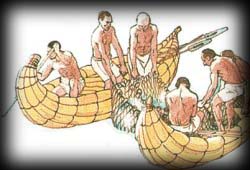 |
|
|
|
Home | More Articles | Papyrus | Cartouche | Ladies Accessories | Home Decor | Mother of Pearl | Rugs | Others |
||
|
|
||
|
|
||
|
|
|
|
|
|
|
|
Ancient Egyptian Boats
|
Egyptians
pioneered the development of river craft and there were many different
types built for various uses. Agricultural produce, troops, cattle,
stone and funeral processions were all carried on the Nile and its
canals. These boats were made of bundles of bound papyrus reeds.
Papyrus is different from paper because papyrus is a laminated material
made from thinly cut strips from the stalk of Cyprus Papyrus plant
It
was believed to be first used about 4000 B.C., and became Egypt's major
exports.
There were many types of
boats that Egyptians used. Papyrus boats were used by Egyptians.
Papyrus boats were built with bundles of papyrus. They were steered with
oars. Sailboats were used a lot by Egyptians. Sailboats were steered
by two oars. Sailboats usually only had one square sail. Funeral
boats carried dead people down river. They were used to carry the dead
across the Nile River. The funeral boats were very elaborate.
The
earliest record of a ship under sail is depicted on an Egyptian pot dating back
to 3200BC. These Egyptian boats were made of either native woods or conifers
from Lebanon.
|
|
Cedar
was very important to the Egyptians as a boat building material. These boats
were built of relatively short blocks of timber, and were braced and secured
with rope lashings very much in the same style that was used in papyrus boats.
This wooden model of the funery boats found at Thebes, with its two pointed ends
rising out of the water, is a good example.
All
the cities and towns were easily accessible by boat, and the Nile provided the
perfect means of transport, since it was cheap and quick. The necessary water
power was provided by the
current
and the wind.
Officials went up and down the Nile with stone for building projects or grain
for the kings stores, and merchants carried wares for sale. Every corner of
civilized Egypt could be easily
could
be easily reached and Egyptian traders sailed to ports in the Eastern
Mediterranean and the Red Sea.
| Fishing from a papyrus boat |
 |
Funeral
boats were very elegant and took the pharaoh to the grave. The funeral
boats were buried with the pharaoh. The Egyptians only used chisels to cut
boats from wood. It took them a very long time to make a boat. Khufuís
boat was 141 feet long and didnot even have a nail in it. The Egyptians
had a hard time making and sailing boats. There were papyrus and
sailing boats too.
Building and sailing for the Egyptians wasn't always easy. The Egyptians had a hard time sailing a boat. Rowing a boat was a hard job because the boats were so big and heavy. It was also a hard job because the oars the Egyptians steered with were very heavy. Egyptians had a hard time building boats too. Making a boat was a very long and hard job because the boats were big. Boats were hard to make because all the Egyptians had to cut the wood with was a chisel. Sailing was easy too. Sails just carried the Egyptians which ever way the wind was blowing. Which is up the Nile River, against the current.
| These are the tools used for making a boat. |
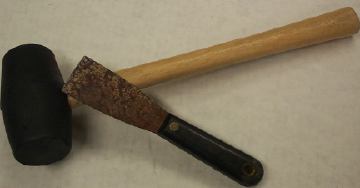 |
In
the pyramid of King Khufu, the worlds oldest boat was found. It's 1200 pieces
were found stored unassembled, with matching hieratic signs, (which were a
written version of hieroglyphics). These hieratic signs indicated to which
quarter of the boat the parts belonged.
Khufu's
barge measured 150 feet from long beam to stern. Different theories arose and to
the intended use of the boat. Was it for Khufu's use in the afterlife? Or as
some believe , was it part of the funeral cortege , which may have carried his
body from Memphis to Giza.
vThe
boat's 1,224 separate components included cedarwood planking and oars, ropes of
halfa grass, wooden dowels and battens, and copper staples. Its near-perfect
preservation allowed conservators to reconstruct the 144-foot-long craft, which
is now housed in a white museum built over the pit where it was found. Modern
ropes were used to lash it together, but its timbers are 95 percent original.

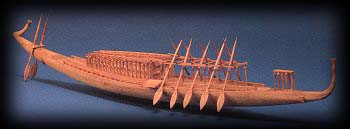
| Model funeral boat , which would have carried the deceased on their final journey on the nile, to their tomb. c 1900BC.(British Museum) |
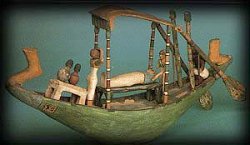 |
| Testing the depth of the water, while the large oar is used for steering |
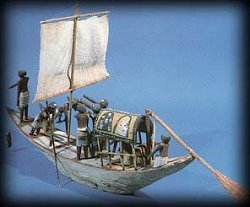 |
The
Abydos ships:
In
1991 in the desert near the temple of Khentyamentiu, archaeologists uncovered
the remains of 14 ships dating back to the early
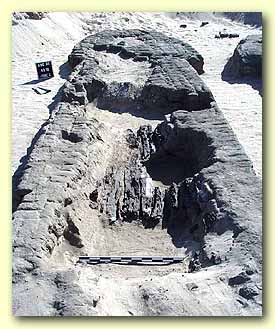 first
dynasty (2950-2775 BC), possibly associated with King Aha, the first ruler of
that dynasty. These 75 foot long ships are buried side by side and have wooden
hulls, rough stone boulders which were used as anchors, and "sewn"
wooden planks. Also found within their desert graves were remains of the woven
straps that joined the planks, as well as reed bundles that were used to seal
seams between planks. The Abydos ships have the honor of being the world’s
oldest planked boats.
first
dynasty (2950-2775 BC), possibly associated with King Aha, the first ruler of
that dynasty. These 75 foot long ships are buried side by side and have wooden
hulls, rough stone boulders which were used as anchors, and "sewn"
wooden planks. Also found within their desert graves were remains of the woven
straps that joined the planks, as well as reed bundles that were used to seal
seams between planks. The Abydos ships have the honor of being the world’s
oldest planked boats.
The
ancient Egyptians were creating ships with technological skills far beyond their
time, well before the invention of the wheel. Egyptologists suspect that simple
light rafts made from bundled papyrus reeds may have been made by
hunter-gatherers who moved to the Nile Valley during the Upper Paleolithic
period; of course, no specimens remain today. However, there is evidence of the
presence of boats in the Naqada II culture, which immediately preceded the
dynastic period. Archaeologists have unearthed red painted pottery with designs
that include boat motifs as important symbols, and some interpretations stress
the boats were used in a religious or ritual capacity. Further evidence for the
early use of boats lies in tomb reliefs (ship building scenes were among the
most popular motifs in tombs), paintings, and model boats dating from
predynastic times through the New Kingdom.
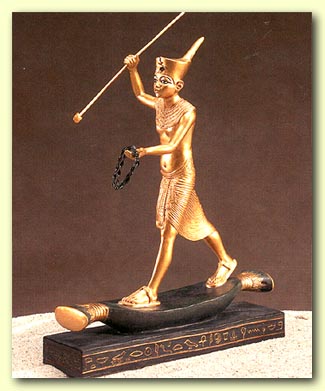 Papyrus
rafts appeared to gain a somewhat sacred significance as far back as the first
dynasty because of their association with the sun god. The earliest depictions
of the sun god show him travelling on a reed float made of bound papyrus, a
portrayal so ancient that it predated Egyptian knowledge of wooden ships. It is
because of this connection with the sun god that the papyrus raft gained its
religious significance, and even though it was used for more practical purposes
in Egyptian civilization, the sacred and royal association stuck.
Papyrus
rafts appeared to gain a somewhat sacred significance as far back as the first
dynasty because of their association with the sun god. The earliest depictions
of the sun god show him travelling on a reed float made of bound papyrus, a
portrayal so ancient that it predated Egyptian knowledge of wooden ships. It is
because of this connection with the sun god that the papyrus raft gained its
religious significance, and even though it was used for more practical purposes
in Egyptian civilization, the sacred and royal association stuck.
Over time, ancient Egyptians created
and utilized three types of
boats,
each with its own purpose. Simple reed rafts were used mostly for hunting in
marshes and as time progressed, they were used less frequently on the Nile.
Wooden boats generally replaced papyrus rafts for Nile travel, and, since they
were faster and more stable than rafts, they were also used for transport.
Eventually stronger wooden boats were used for lengthy ocean excursions as well
as to transport boulder blocks weighing many tons and obelisks weighing hundreds
of pounds from quarries to pyramid and temple building sites. The third type of
boat was the papyriform boat, made technologically similar to wooden boats but
with the shape of an elaborate papyrus raft in order to maintain the connection
to royalty and gods. These ships appear to have been used as pleasure boats and
transportation for royalty; they were also used as funerary boats and burial
boats, as well as in religious events like pilgrimages and transporting the
statue of a god.
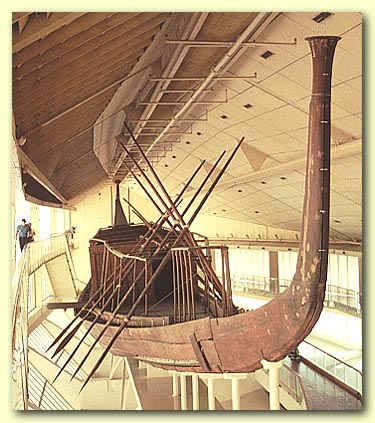 The
famous Royal
Ship of King Cheops (fourth dynasty ruler of the Old Kingdom), more
formally known as Khufu, is a perfect example of a papyriform boat. Discovered
around 1954, the Royal Ship is still considered to be one of the world’s most
outstanding archaeological artifacts. The ancient boat had been dismantled into
651 separate parts, and its nearly perfectly preserved timbers were found in 13
scrupulously arranged layers that were buried in a sealed boat pit which was
carved into the Giza plateau’s limestone bedrock. It took years for the boat
to be painstakingly reassembled, primarily by the Egyptian Department of
Antiquities’ chief restorer, Ahmed Youssef Moustafa (later known as Hag Ahmed
Youssef). Once completed, the Royal Ship measured approximately 150 feet in
length. The timbers were made of Lebanese cedar while the pegs and other small
parts were made from native acacias, sycamores and sidders.
The
famous Royal
Ship of King Cheops (fourth dynasty ruler of the Old Kingdom), more
formally known as Khufu, is a perfect example of a papyriform boat. Discovered
around 1954, the Royal Ship is still considered to be one of the world’s most
outstanding archaeological artifacts. The ancient boat had been dismantled into
651 separate parts, and its nearly perfectly preserved timbers were found in 13
scrupulously arranged layers that were buried in a sealed boat pit which was
carved into the Giza plateau’s limestone bedrock. It took years for the boat
to be painstakingly reassembled, primarily by the Egyptian Department of
Antiquities’ chief restorer, Ahmed Youssef Moustafa (later known as Hag Ahmed
Youssef). Once completed, the Royal Ship measured approximately 150 feet in
length. The timbers were made of Lebanese cedar while the pegs and other small
parts were made from native acacias, sycamores and sidders.
Cedar
was not new to the Egypt of Cheops' time - it had been found in predynastic
graves, indicating to modern archaeologists that trade had occurred with Lebanon
at least as far back as the end of the fourth millennium BC. Egyptians had what
has been termed as an "emotional need" for trade with Lebanon because
of that country’s large supply of the invaluable resinous woods and oils so
necessary in Egyptian funerary customs. Trade with Lebanon had to be conducted
over water, because the Egyptians had neither wheeled transportation nor heavy
draft animals, and the brutal desert regions through which they would have had
to travel hosted hostile tribes.
The
supposition is that heavy ships and smaller trading ships were most likely
constructed in the Nile Valley, then dismantled and carried piecemeal to Qoseir
where they were reassembled and put in the sea. In general, sea-going boats were
referred to by the ancient Egyptians as "Byblos boats" because the
earliest seaworthy boats’ initial trade was with the Lebanese port town of
Byblos.
Transportation
and trade were not the only reasons for seaworthy boats to be built in ancient
Egypt. The pharaohs also recognized the need for a powerful navy.
Many
pharaohs achieved incredible feats with their fleets, such as Queen
Hatshepsut’s voyage to Punt, but from the 20th dynasty on, they improved their
ships even more by copying some of the more advanced models used by other
cultures. Herodotus describes the Egyptians as having boats "in great
numbers" and carrying "many thousands of talents’ burden".
Papyriform
boats were also used to transport images of important gods, but these vessels
were never intended to be put in the water. The image of the god would be placed
upon a gold encrusted papyriform barque studded with gems that was carried on
the shoulders of priests who took it to its place of honor. If this journey
included a trip on the Nile, the golden barque was put on a papyriform transport
boat and taken to its destination.
From
boat pits such as those of Cheops and at Abydos, we know that actual full-sized
boats were buried with the dead to take them on their journey in the afterlife,
but by the twelfth dynasty this practice became too expensive. So instead,
models of boats were placed in the tombs, which would serve the same purpose as
the full-sized vessels. In addition to models of boats, there were also
miniature models of daily life, including bakeries, butcher shops, and
potters’ studios. These models have given archaeologists wonderful glimpses
into ancient life.
While
royal papyri form vessels remained relatively unchanged throughout the centuries,
the hundreds of model boats found in private tombs show a tremendous variety of
shapes. Unlike court artisans who were strictly held to tradition, private
artists could customize their clients’ models according to their wishes or
they could produce models with their own creative touches, as long as they
stayed within certain basic limits.
|
|
|
You may freely reprint this article or place it on your website by adding this statement: Courtesy of www.kingtutshop.com |
| Home |
| Contact us |
| Rugs Kilim | Tapestries |
| Other Rosetta Stone | Egyptian Thrones |
|
Mother of Pearl Boxes | Paper Clips | Photo Frames | Plates |
| Home Decor Hang to wall plates | Candle Holder | Perfume Warmer |
| Free Information Ancient Egyptian Civilization and Egyptology Articles |
| Ladies Accessories Egyptian Silver Jewelry | Bracelets | Necklaces | Earrings | Perfume Bottles | Pharaohs bags |
| Egyptian Cartouches Egyptian 18K Gold Cartouches | Egyptian Silver Cartouches | Silver with Gold Cartouche |
| Papyrus Strips | Papyrus Kit | Writing Kit | Blank Sheets | Paintings | Wedding Invitations | Logos | Papyrus outlines |
| Others Payment | FAQ | Retailers | M Distributors| Testimonial | What's New | Special Offer | Catalog | Links | Add Site | affiliate | Site Map |
| Misc. : Papyrus Calendar | Papyrus Coaster | Papyrus Book Marks | Mouse Pad | Note Books | Hieroglyphic stickers |